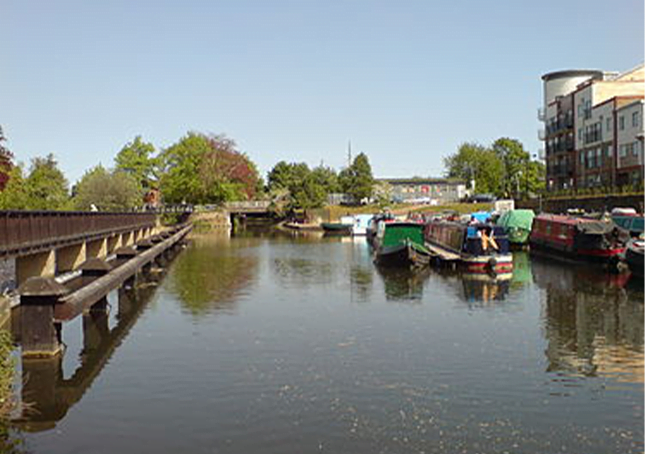River Lea

The River Lea, also spelled Lee, is a river in South East England. It originates in the Bedfordshire part of the Chiltern Hills, and flows southeast through Hertfordshire and then Greater London, sometimes through several channels, to ultimately meet the River Thames, the last looping section being known as Bow Creek. It is one of the largest rivers in London and the easternmost major tributary of the Thames.
The river’s significance as a major east-west barrier and boundary has tended to obscure its importance as north-south trade route. Below Hertford the river has since medieval times had alterations made to make it more navigable for boats between the Thames and eastern Hertfordshire and Essex, known as the Lee Navigation.
This stimulated much industry along its banks. The navigable River Stort, a main tributary, joins it at Hoddesdon.
While the lower Lea remains somewhat polluted, its upper stretch and tributaries, classified as chalk streams, are a major source of drinking water for London.
An artificial waterway known as the New River, opened in 1613, abstracts clean water away from the upper stretch of the river near Hertford for drinking, and lower parts of the river are also abstracted from. The Lea’s origin in the Chilterns contributes to the extreme hardness (high mineral content) of London tap water.
The name of the River Lea was first recorded in the 9th century, although is believed to be much older. Spellings from the Anglo-Saxon period include Lig(e)an in 880 and Lygan in 895, and in the early medieval period it is usually Luye or Leye.
It seems to be derived from a Celtic (brythonic) root lug-meaning ‘bright or light’ which is also the derivation of a name for a deity, so the meaning may be ‘bright river’ or ‘river dedicated to the god Lugus’. A simpler derivation may well be the Brythonic word cognate with the modern Welsh “Li” pronounced “Lea” which means a flow or a current.
The river is the major component in a number of place-names, including Leagrave, the suburb of Luton where the source of the river is located, and of Luton and Leyton: both mean “farmstead on the River Lea”.
